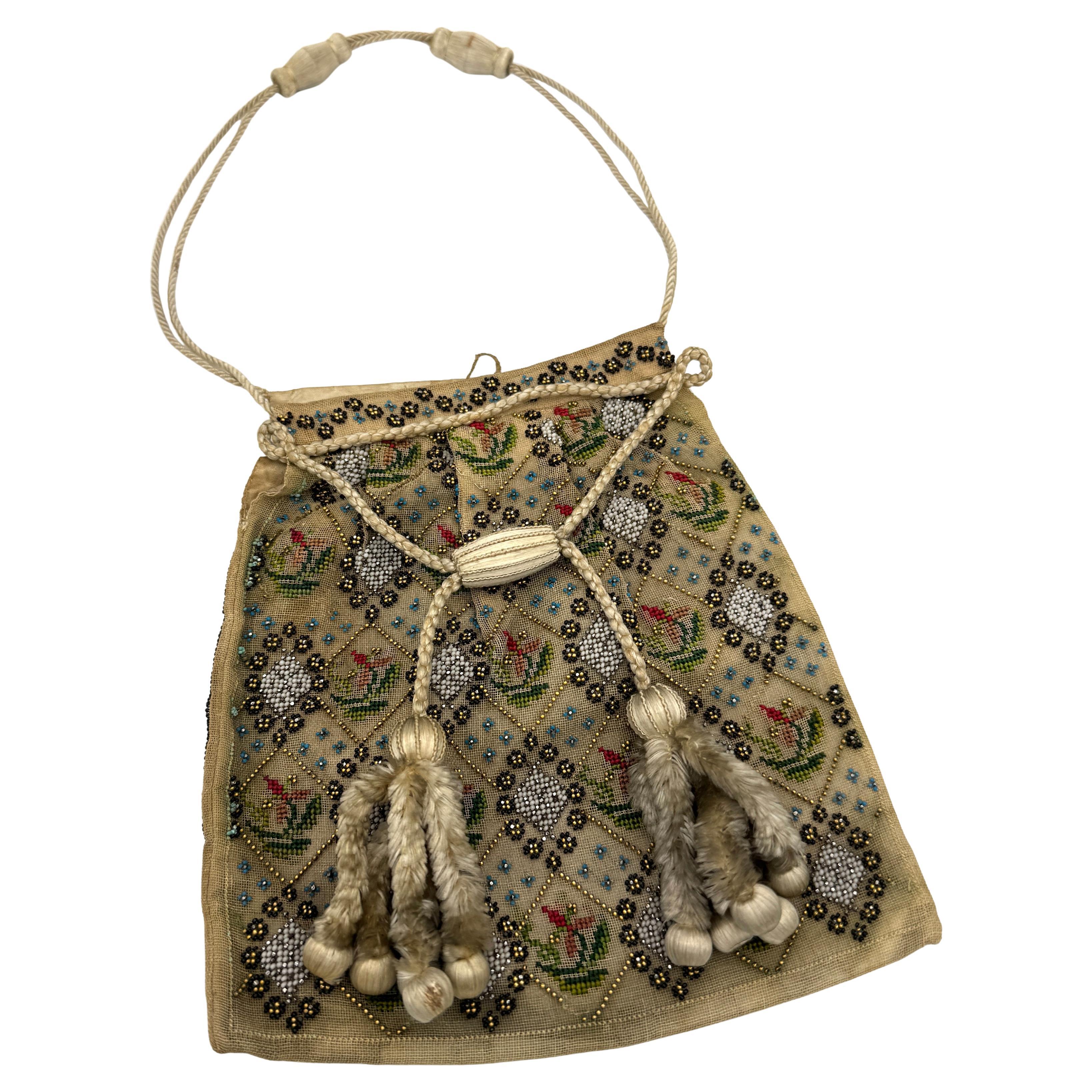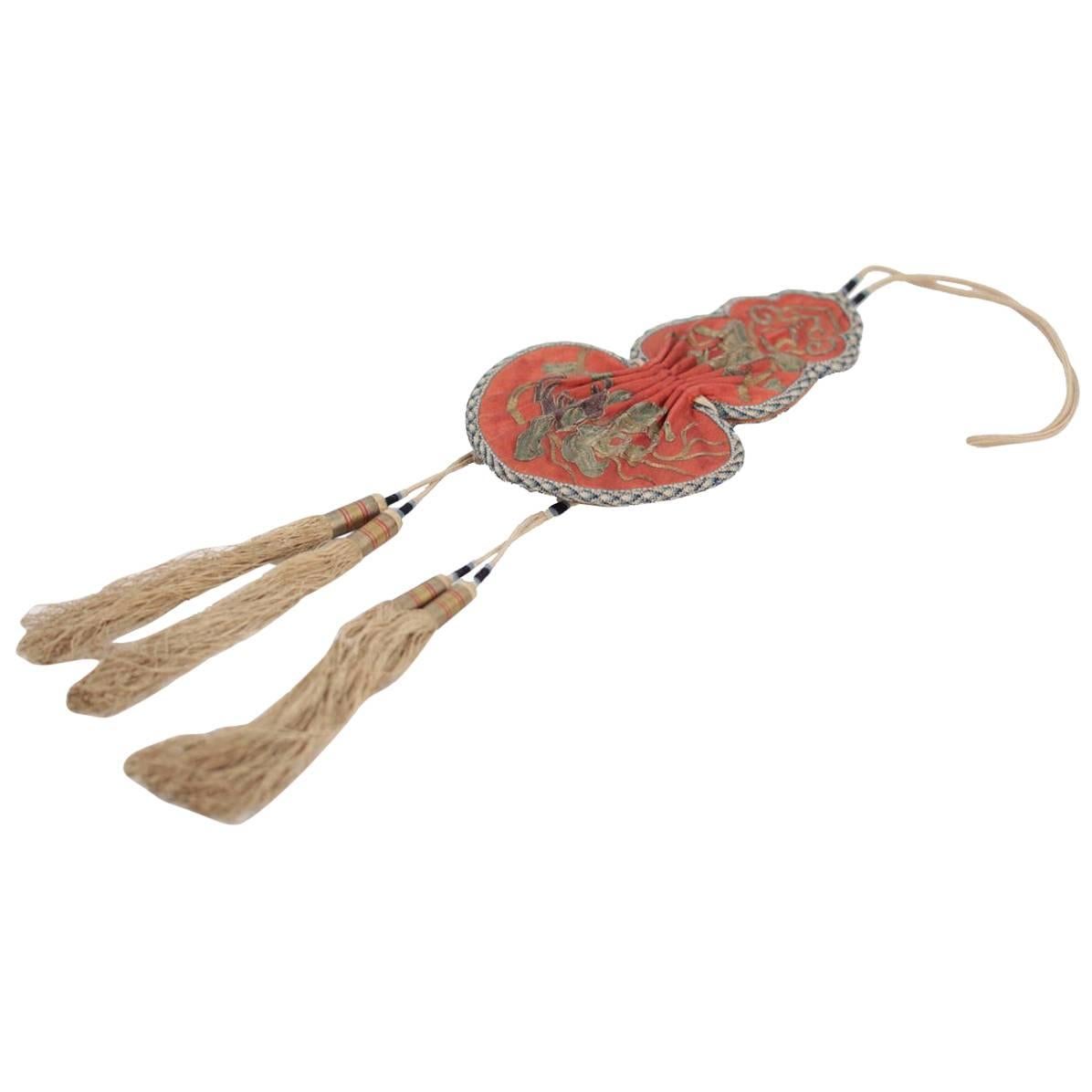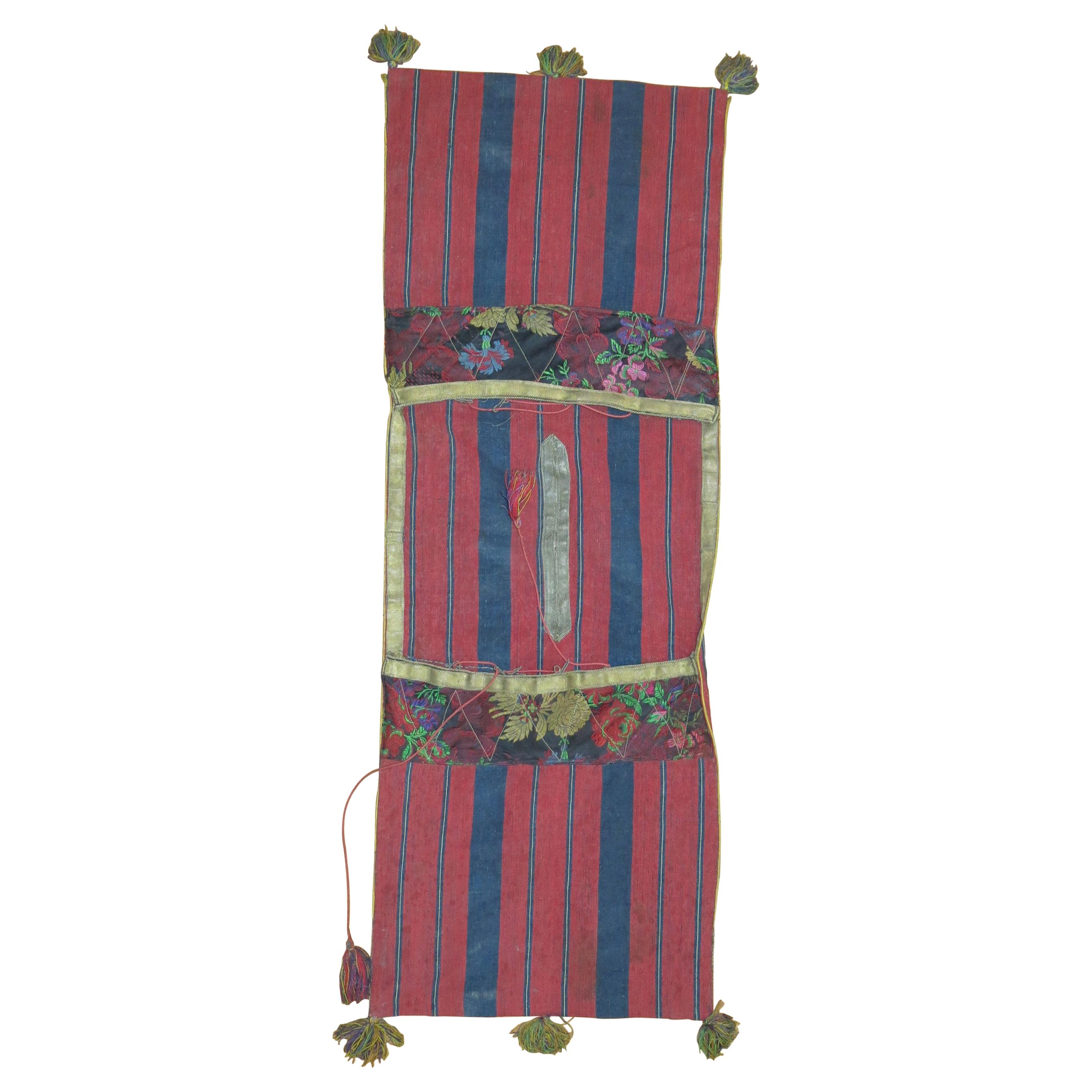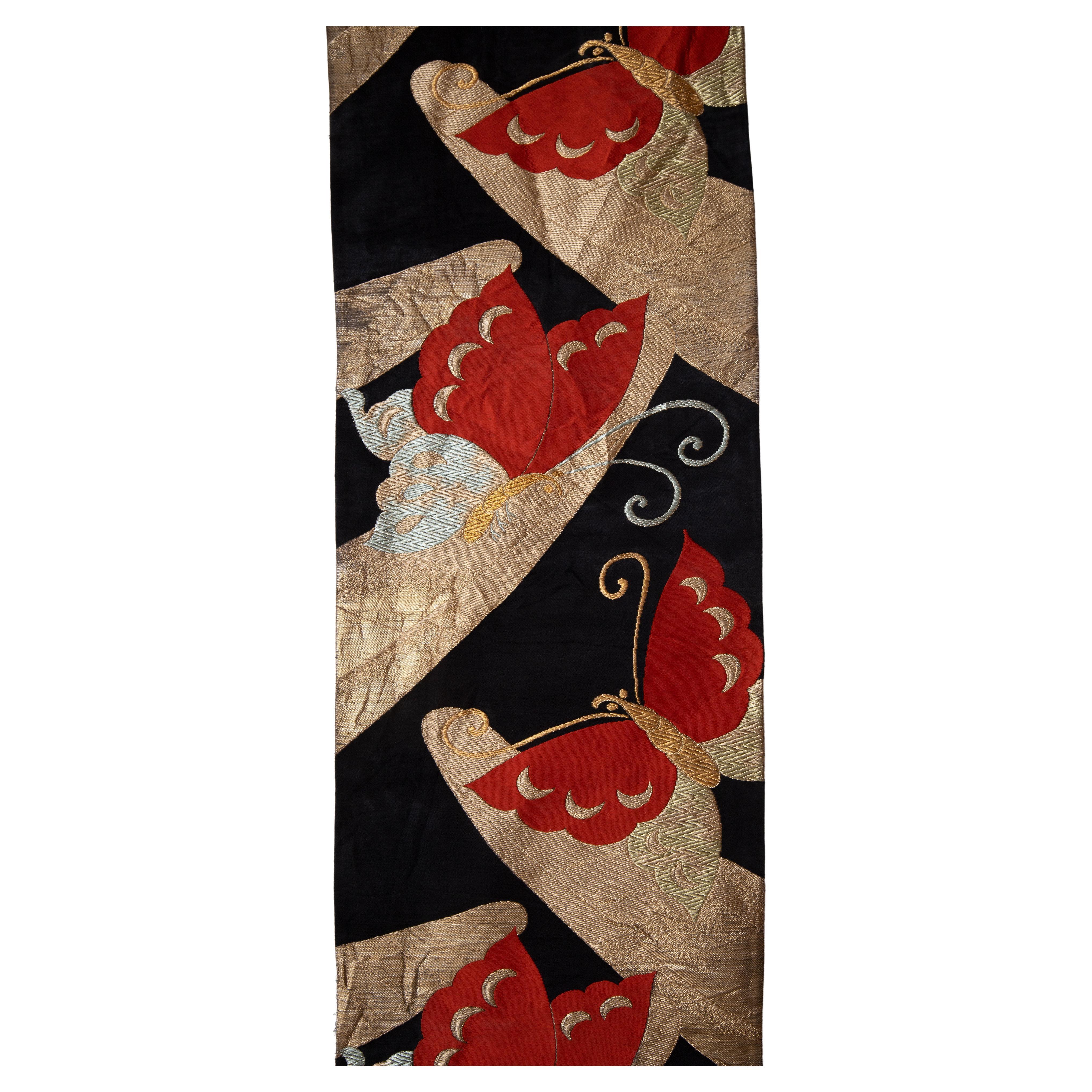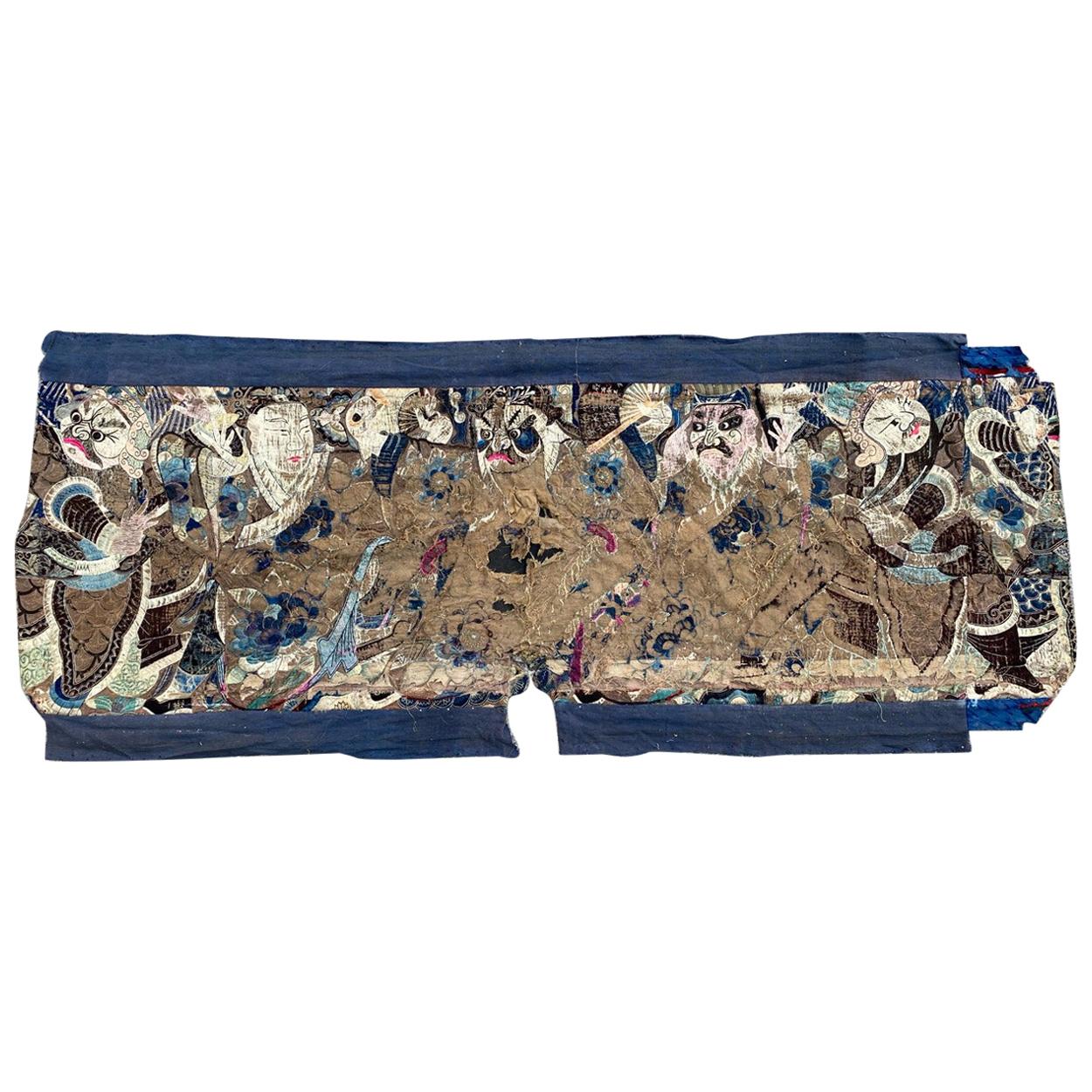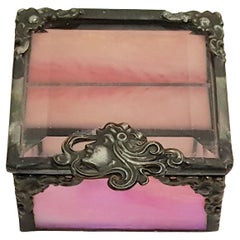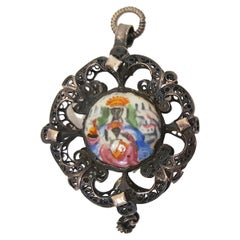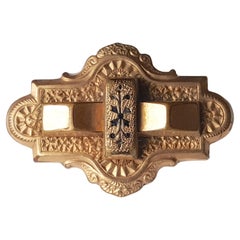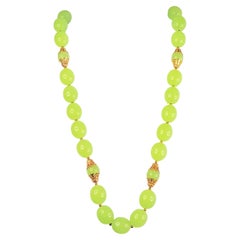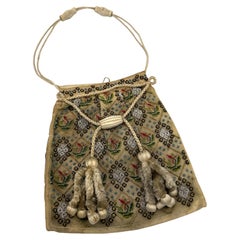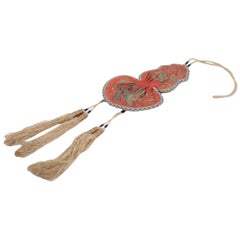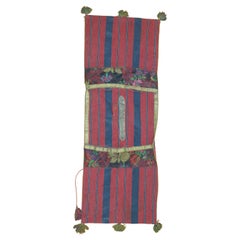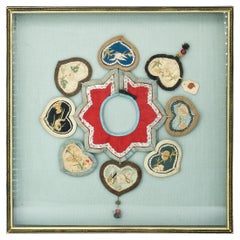Items Similar to Antique Japanese WovenSilk PaintedCeramicOjimes Beadwork Embroidery Inro
Want more images or videos?
Request additional images or videos from the seller
1 of 14
Antique Japanese WovenSilk PaintedCeramicOjimes Beadwork Embroidery Inro
$510
£386.44
€442.63
CA$722.36
A$788.26
CHF 413.46
MX$9,573.68
NOK 5,164.29
SEK 4,880.51
DKK 3,303.63
About the Item
This rare antique Edo-period (1615-1868) Japanese handmade inro is a curved lozenge-shaped hand-dyed woven-silk hard carrying-case container sheath that features intricate embroidery with rock-crystal or glass beadwork and thin leather-wrapped thread appliques. For its "Kimono Style" exhibition, TheMet museum noted: "the dying, weaving, and embroidery techniques for which Japan is famed reached their peak of artistic sophistication during the Edo period."
On the burgundy finely-braided silk obijime cord that suspends the inro hang adjustable ojime fasteners of glazed earthenware, which are hand-painted with underglaze and overglaze enamels. The imagery includes signature-like branches, mountains, and a pine tree. Each knotted end of the cord dangles from the bottom of the inro with two rice-paper tubular beads.
We could not find any Japanese beads constructed from handmade rice-paper like this in any online-accessible museum collection. The long-ago artist who made this and the other handcrafted elements was an expert in multiple artistic skills beyond the typical inro maker.
In the same elongated shape of our inro, we found one with ball-shaped ojime at the V&A museum that was made in the 18th Century by Ogawa Haritsu, who was an inro master also specialized in ceramics and painting who died in 1747. The V&A noted that he had a talented apprentice, Mochizuchi Hanzan, who continued to innovate in his master's style during the rest of the century.
The only other inro among hundreds in its collection that has a painted ceramic ojime like ours is dated 1750 to 1800. The V&A noted: "ceramic inro are unusual, especially at this early date. The background of this design suggests that it imitates leather. During the late 1700s and early 1800s Dutch leather became popular in Japan and the craftsman who made this probably had knowledge of such exotic wares."
The same two embroidered designs appear on each side, whereby the top one may be an animal with a long neck or tail like a dragon, while the bottom one may be fruits, flowers or clouds.
While the threads seem hand-woven to the mostly concealed organic material, the distressed exterior is covered in grey silk, while the interior has a teal-silk rim and undyed-silk lining. On one side of the inro there is bead loss at the top. On the other side, there is leather-wrapped thread loss at the bottom.
Most inro were made for men from durable materials in rectangular shapes and multiple sections so that they could enclose small items of importance, like a seal, to a sash tied on the torso to close their kimono. Since this textile-and-ceramic one that seems to conceal a hand-carved or basketry base has such a delicate exterior, we assume it was a costly fashion accessory custom-made for a geisha's kimono with little or no function. Although, there was a match box inserted by the previous owner that we removed.
With the Japanese adoption of Western dress since the late 19th Century, inro and their makers mostly disappeared, while much of the knowledge and skills to make them were lost. Since the late Edo period the artistic value of inro increased, as they were no longer used as an accessory and came to be regarded as an art object for collection.
- Dimensions:Width: 2 in (5.08 cm)Depth: 1 in (2.54 cm)Length: 14 in (35.56 cm)
- Style:18th Century (Of the Period)
- Place of Origin:
- Period:18th Century
- Condition:Wear consistent with age and use.
- Seller Location:Chicago, IL
- Reference Number:1stDibs: LU3244220103712
About the Seller
5.0
Gold Seller
Premium sellers maintaining a 4.3+ rating and 24-hour response times
Established in 2012
1stDibs seller since 2022
30 sales on 1stDibs
Typical response time: 1 hour
- ShippingRetrieving quote...Shipping from: North Adams, MA
- Return Policy
Authenticity Guarantee
In the unlikely event there’s an issue with an item’s authenticity, contact us within 1 year for a full refund. DetailsMoney-Back Guarantee
If your item is not as described, is damaged in transit, or does not arrive, contact us within 7 days for a full refund. Details24-Hour Cancellation
You have a 24-hour grace period in which to reconsider your purchase, with no questions asked.Vetted Professional Sellers
Our world-class sellers must adhere to strict standards for service and quality, maintaining the integrity of our listings.Price-Match Guarantee
If you find that a seller listed the same item for a lower price elsewhere, we’ll match it.Trusted Global Delivery
Our best-in-class carrier network provides specialized shipping options worldwide, including custom delivery.More From This Seller
View AllAntique French ArtNouveau MuchaMajorelleGruberStyle SignedNancyGlass SilveredBox
By Daum
Located in Chicago, IL
Influenced by the Art Nouveau illustrations of Alphonse Mucha, this antique French jewelry box display case is decorated with silvered bronze or ...
Category
Antique 1890s French Art Nouveau Figurines and Sculptures
Materials
Gilt Metal, Mixed Metal, Silver Plate, Brass, Bronze
18thC EnamelDoublePainting SilverFiligree SpanishRococo AprilBirthday Pendant
Located in Chicago, IL
This early 18th-Century Spanish Rococo period silver-filigree double-sided pendant with dangle features miniature colorful enamel devotional paintings on both sides of a white porcelain centerpiece, which are associated with an April birth.
One side depicts a mountain landscape with a haloed richly-robed dark woman holding a lap-seated dark child and a holy orb...
Category
Antique Early 18th Century Spanish Rococo Pendant Necklaces
Materials
Silver, Enamel
Renaissance FleurDeLis Niello HighRelief GiltEngraved Heraldry Reliquary Jewelry
Located in Chicago, IL
Demonstrating the epitome of miniature decorative art by Renaissance European goldsmiths who fashioned quatrefoil and/or cruciform jewelry with heraldry or religious symbols, this ce...
Category
Antique 16th Century European Renaissance Brooches
Materials
Gilt Metal, Niello, Silver, Copper
Antique HandPressed Glass European GoldFiligreeCapped Beaded Heavy Necklace
Located in Chicago, IL
This antique rare hand-pressed-glass necklace features semi-translucent grape-green large beads that are capped with gilt-brass filigree. Based on the combination of bead seams, spring-ring clasp, and metal findings on the unmarked faux Chinese-jade necklace, it dates to the late Victorian period most likely from Western Europe.
Around WWI, hand presses, which stamped molten glass into a mold to create a bead with a hole and a seam, were often used to produce costume jewelry as a cottage industry in Germany and the Czech region. This was while there was a lack of factory machine presses and finishing tumblers that used sand to polish out the seam lines.
Another reason that the cloudy green beads can be identified as atypically hand-pressed is that they are more opaque and therefore harder and less prone to breaking during formation than fully-translucent glass, which was better suited for automated-machine pressing. Also the green beads are an unusual swirled color including white, which suggests that their production was more limited than machine-pressing would enable.
Without the bead-seams, this necklace could be mistaken for one by Coco Chanel. Her 1920s couture...
Category
Early 20th Century German Late Victorian Beaded Necklaces
Materials
Gold, Brass, Gilt Metal
Georgian Early1800s Cannetille Filigree WiredPearl FloralSpray RedSilk PinBrooch
By Artistian Made
Located in Chicago, IL
Inspired by folk embroidery, filigree jewelry transformed in the early 1800s during the Georgian period into labor-intensive cannetille, like this antique handmade intricately-wired metal-frame brooch depicting a floral spray. Resembling Silesian wire-ornamentation, this metallic wire and red braided-thread brooch...
Category
Antique Early 19th Century European Georgian Brooches
Materials
Pearl, Freshwater Pearl, Gilt Metal, Berlin Iron
YBA YoungBritishArtist Sculpture Jewelry Costume First US Exhibit NYC 2000-2001
By Contemporary
Located in Chicago, IL
Young British artist (YBA) Philippe Bradshaw (1965-2005) was represented by blue-chip international art galleries when he was the first to reimagine iconic-art images as tapestry-like metal-chain installations in evolving multimedia environments. He is best known for transforming hand-assembled colorful anodized-aluminum links into shimmering semi-transparent layered curtains, whose hanging metallic strands uniquely dispersed the light of his camcorder-video projections and the club-house music from records that he deejayed.
In Bradshaw's first American exhibition "Disco Damage" in 2001 at New York City's legendary avant-garde art gallery, Deitch Projects, this jewelry-costume sculpture became part of the artist's live-in evolving studio installation. While later celebrating 15 years of art happenings that had occurred at that Soho exhibition space, its gallerist-cum-museum-director Jeffrey Deitch--who was physically scarred during this unforgettable chaotic several-month experience orchestrated by Bradshaw--recounted this show in his retrospective hardcover book "Live The Art".
When Bradshaw drowned in the Parisian-river Seine in August 2005 while living the high life of his skyrocketing success in Europe, he left a small body of large installations that is mostly distributed among the world's top private art collections. Notably, the Museum of Contemporary Art in Los Angeles has acquired one of his multimedia works. More recently, another assembly of his chain curtains made a rare public appearance at new modern-art museum, Heidi Horten Collection, during its inaugural exhibition in Vienna.
Since winning a major British visual-art prize in 2000 that marked Bradshaw's art-world ascent following fellow Goldsmiths-College YBAs who were close friends, this sculpture evolved from one of his most elaborate jewelry costumes that he created in London while seducing the American who became his girlfriend. Unlike other pieces of jewelry that he made as gifts to participating acquaintances while video taping...
Category
Early 2000s British Contemporary Figurines and Sculptures
Materials
Mixed Metal
You May Also Like
Antique Early 19th Century Embroidery Silk Handbag Applique Bead work
Located in Munich, Bavaria
This rare and delicate bag was handcrafted in the early 19th century. The silk is covered with a net that is used for embroidering. The handbag is decorated on one side with hand emb...
Category
Antique 1820s European Boxes and Cases
ANTIQUE CHINESE Vase Shape Embroidered Silk SCENT PURSE BAG 19th Century POUCH
Located in Rome, Rome
- Beautiful embroidered Chinese scent pouch. - From the late 19th century (Qing/Ch'ing Dinasty)
- Crafted in pure silk - In the shape of a double gourd vase.
- Intricated filigre...
Category
1930s Chinese Evening Bags and Minaudières
$1,018 Sale Price
32% Off
Vintage Indian Textile
Located in New York, NY
Handwoven Indian textile in reds and blues
Measures: 13'' x 37'.
Category
20th Century Indian Rustic Quilts and Blankets
Materials
Cotton
Antique Chinese Embroidery Brocade Collar Qing Dynasty Crane Floral Asian Arts
Located in Hyattsville, MD
Museum quality antique 1800s Childs collar on baby blue clothe background, appears much lighter in photos. Stamped on verso Sarit Centre Westland’s Nairobi Kenya Africa. Background is baby blue, appears lighter in images.
Measures: Collar diameter 12.5 in. (Beads about 1.75 inches additional.)
Square frame is 17.75 in.
From a Norwegian and then Kenya State Department Official's Estate in Bethesda MD...
Category
Antique Mid-19th Century Chinese Antiquities
Materials
Fabric
$1,520 Sale Price
20% Off
Vintage Japanese Obi Textile, Mid 20th C
Located in Istanbul, TR
An obi in very good condition that can be utilized as a table runner, wall hanging.
Category
Mid-20th Century Japanese Pillows and Throws
Materials
Silk
Antique Distressed Chinese Embroidery
Located in Saint Ouen, FR
Distressed 19th century embroidery from China with a beautiful Chinese design and beautiful colors, entirely handwoven with silk.
Category
Antique Late 19th Century Chinese Chinoiserie Textiles
Materials
Silk
More Ways To Browse
Chanel Rugby
Snow Globe Dome
Hermes Samarcande Paperweight
Louis Vuitton Clear Acrylic Box
Advent Calendar
Chanel 2021 Advent Calendar
Chanel Football
Chanel Skateboard
Fendi Candle
Hermes Mises
Hermes Sushi Plate
Hermes Tigre Tray
Louis Vuitton Doll
Louis Vuitton Paperweight
Vuitton Paperweight
Bianchi Bike
Chanel Snowboard
Croquis Fashion
